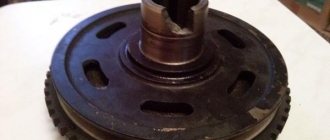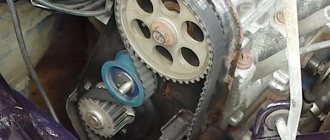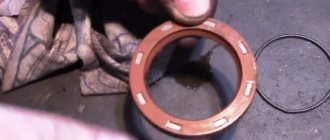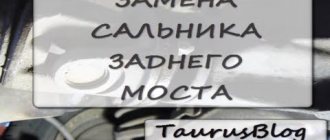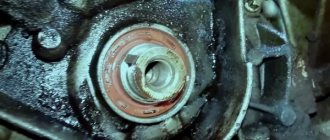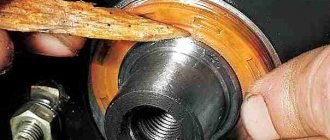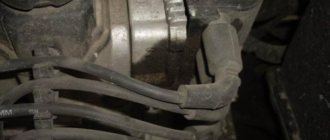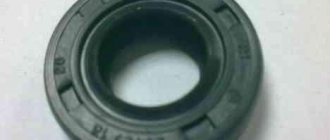08.11.2019
| (Votes: 3, Rating: 5) |
Issues discussed in the material:
- What is the function of crankshaft oil seals?
- Why do oil seals wear out?
- Is it possible to drive a car if the crankshaft seals are leaking?
- How to replace front and rear crankshaft oil seals
When grease leaks from under the crankshaft, it means the seal has worn out. You should not be careless about this problem. Replacing the crankshaft oil seal is the only thing that can help in this case. If repairs are not carried out and the leak is not eliminated, the timing belt will fail. Then you will have to spend a large sum on restoring the engine.
Description and functions of the crankshaft oil seal
For a powertrain to function properly, it needs to be properly lubricated. This is why there is a lubrication system in which oil moves under high pressure. It lubricates all the rubbing surfaces of the internal combustion engine, spraying under pressure. The lubricant can also move by gravity. Typically, power plants use a hybrid-type lubrication system, where one half of the oil is sprayed and the other half flows by gravity.
However, lubricant not only reduces friction between surfaces, but also removes wear products, protects engine elements from damage, and prevents it from overheating. Now notice the crankshaft, which protrudes outward from the engine. In order to prevent oil from leaking out, the hole where it rotates is closed with a seal.
Its role is played by the crankshaft oil seal. 2 seals are used:
- front, it is located next to the crankshaft pulley;
- rear, located in the flywheel area.
The seal can be silicone or rubber. Why are these particular materials used? They are resistant to elevated temperatures and are not affected by lubricants.
This means that the seal will not be damaged due to overheating. After all, when the engine runs at high speeds, it heats up to maximum temperatures. As a result, the size of the parts becomes larger. The oil seal is made in the form of a ring of such a size that it ideally fits the diameter of the crankshaft.
It is located on the cylinder block of the internal combustion engine where the crankshaft protrudes outward. However, the area where the crankshaft exits on the engine may differ depending on the machine.
We recommend
“Turbine engine in a car: its advantages and disadvantages” More details
For example, if you have a domestic car with rear-wheel drive, in which the power unit is located longitudinally and a timing chain is installed, then the seal will be located in the crankshaft shield behind the support bearing.
When the car is front-wheel drive, the engine is mounted transversely and a timing belt is used, the seal will be located in the cylinder block. This is explained by the fact that there are no crankshaft shields on such engines.
Is it possible to drive with worn oil seals?
Further operation of the vehicle is not recommended for several reasons. Firstly, engine oil consumption increases due to its leakage through rubber products. Secondly, the power unit becomes contaminated with adhering dirt and dust.
But, the most compelling reason to refuse to drive a car with leaking oil seals is the fact that loss of oil can lead to serious damage to the internal combustion engine, which can be eliminated by carrying out a major overhaul of the engine.
The most serious breakdown that can occur in a car due to a lubricant leak is considered to be a broken timing belt. On cars, this problem results in expensive repairs, because on many models the valves are prone to bending
Another common problem is transmission malfunction. However, drivers encounter this kind of trouble most often in the event of a malfunction of the rear oil seal. Failures of electrical equipment mechanisms and all kinds of sensors are less common.
Crankshaft oil seal wear: causes and consequences
Replacing the crankshaft oil seal, if it is of high quality, will be required after 100,000 km. But we must not forget that the dimensions of the seal located in the front and the one located in the back are different. Therefore, their service life will be different.
Why it may be necessary to replace the crankshaft oil seal:
- When new oil was poured into the engine, foreign particles got into the area where the seal is located. As a result, microdamage occurred on the crankshaft oil seal, it failed ahead of time and needs to be replaced;
- even taking into account the fact that the seal is made of a material that is not afraid of high temperatures, due to the fact that the part is constantly overheating, a leak may occur;
- replacing the crankshaft oil seal may be necessary if it is made of low-quality material that cannot withstand the load;
- The seal will quickly fail if the motor does not function properly. For example, the pressure of crankcase gases is increased, crankshaft beating is observed, as a result, the part will have to be replaced, because it will be squeezed out of its seat;
- Replacing the crankshaft oil seal is inevitable if it was installed incorrectly, because in this case its service life will be noticeably reduced. A leak may occur due to the fact that when replacing the seal, the technician installed it incorrectly or the part was deformed.
Those car enthusiasts who have a Russian-made car note that replacing the front crankshaft oil seal may be necessary earlier, since it often fails after 30,000 kilometers. Lubricant will flow out, even if at first glance the part seems to be working properly.
You cannot continue driving your car without replacing the crankshaft oil seal. The fact is that in this case the car will consume too much oil due to its leakage through the seal. In addition, the motor will become dirty: microparticles of dust will stick to it.
We recommend
“Methods of boosting the engine: in what cases are they used and how” Read more
However, the most unpleasant consequence that awaits you if you do not replace the crankshaft oil seal is failure of the power plant. Due to a leak, the lubricant will not be enough, but the engine will continue to work, as a result, a major overhaul with serious investments may be required.
The worst thing is if the timing belt breaks due to untimely replacement of the crankshaft oil seal. To restore the engine after such a breakdown, you will have to spend a large sum, because the valves will bend.
In addition, the transmission will not work properly. If the seal becomes unusable, the car's electrics and sensors may fail.
Working principle of the crankshaft oil seal
The oil seal is installed in the place of the block where the crankshaft comes out. In classic cars, where the engine is installed along the hood space, and gas distribution occurs via a metal chain drive, the oil seal is installed in the crankshaft shield in front of the support bearing. Front-wheel drive engines or those with a rubber timing belt are installed in the block itself, since shields are not used on them. However, in both cases, the oil seal has the same purpose - to prevent oil leakage from the cylinder block.
Oil pressure is created inside the crankcase, which presses the oil seal against the parts being sealed. Thus, it ensures reliable sealing of the engine against lubricant leakage.
Replacing the crankshaft oil seal: detailed instructions
Before you begin repair work, you should find out which crankshaft oil seal needs to be replaced. The engine has:
- Rear seal . This is a large item. Typically, replacing the crankshaft rear oil seal is rarely required, because its service life is quite long.
- Front seal . Its dimensions are slightly smaller, just like its service life. The front seal fails much more often than the rear.
How to determine which seal has become unusable? To do this, inspect the pan and transmission block to find out which part of the engine is leaking.
The leaked lubricant will help determine whether the rear crankshaft seals or the front ones need to be replaced. Just take some oil and drop it into a container of water. If it is gearbox lubricant, it will spread over the surface of the water. Engine oil will not change the shape of the droplet even in water.
Now let's start inspecting the seals. Your goal is to find the leak. Pay attention to the condition of the oil pump gasket. Since these parts are located close to each other, it may appear that the seal is leaking when in fact the oil pump gasket needs to be replaced.
The technology for replacing the crankshaft oil seal is as follows: first, a new front seal is installed, which is located on the drive side of the gas distribution mechanism. Then the seal on the gearbox side is replaced.
How to replace the crankshaft oil seal? There are two ways: simple and complex. The first one was invented by car owners trying to make repairs as quickly as possible. The second method was developed by specialists, and this is what we will describe below.
What to do:
- We drive the vehicle onto the overpass and secure it securely. We remove the engine protection, as well as the timing cover. Remove the battery terminals and then drain the engine oil.
- We remove the six bolts protecting the engine compartment on the right.
- We loosen the generator belt, then dismantle it.
- After the front wheel on the right is removed, you need to engage a low gear. You will need a nineteen key; use it to carefully loosen the pulley bolt so as not to tear it off. Then unscrew it completely and remove the crankshaft pulley. Note! The crankshaft key should be placed in a safe place; if it is lost, the pulley will not function properly.
- Then we install the piston of the 1st cylinder at top dead center. To control its location, look at the mark in the engine flywheel hatch, as well as at the mark on the timing shaft. This must be done with the front wheel raised and 5th gear engaged.
- After this, loosen the tension roller and remove the timing belt.
We recommend
“Why engine oil foams and what to do about it” Read more
- To remove the lower cover of the clutch housing, unscrew the fastening bolts. It should be removed along with the gasket.
- Next, unscrew the 16 bolts securing the engine crankcase cover and remove it. Important! A new gasket should be installed during assembly.
- Now we proceed to dismantling the oil receiver from the oil pump, as well as the main bearing. To do this, unscrew the mounting bolts by ten.
- Using 2 screwdrivers, remove the toothed pulley from the shaft and unscrew the oil pump mounting bolts. It will come off along with the crankshaft oil seal. The seal can be pulled out easily if you use something sharp. To make the new oil seal fit easier, lubricate it with oil. You can press in the seal using a mandrel or an old oil seal.
- Reinstall the removed parts in reverse order.
Location of rubber elements on the crankshaft
In the design of power plants, two oil seals are used on the crankshafts - front and rear. They both prevent lubricant from leaking out of the engine. The rear oil seal is installed on the end of the shaft to which the flywheel is screwed. Due to the fact that this end switch is presented in the form of a flange, the dimensions of the oil seal are quite large, with a significant layer of rubber. This ensures a considerable service life of the rubber element.
The front oil seal is located on the end of the shaft, which is used as a drive for systems and mechanisms of the power plant or auxiliary equipment. The rubber element is located behind the drive gear, which is mounted on the shaft end and secured with a key connection. The dimensions of this oil seal are smaller than the rear one. And this affects the resource of the element.
Due to the leak, oil gets onto the outer surface of the engine, causing it to become dirty. This also increases the consumption of lubricant, which must be replenished periodically. Leakage is especially dangerous for engines in which the timing belt is driven by a belt. Oil-based liquids have a negative effect on rubber elements. If oil gets in, the belt can delaminate and break, which is especially dangerous if the engine is “plug-in” (if the belt breaks, the pistons collide with the valves).
Features of replacing the crankshaft oil seal on different engines
The easiest way to replace the crankshaft oil seal is on domestic cars, starting with the Lada-2108, which has an eight-valve gas distribution mechanism. The only difficulty is unscrewing the pulley mounting bolt. It is recommended to engage the gearbox and apply the brakes to prevent the engine from spinning.
If the engine has sixteen valves, replacing the crankshaft oil seal will not be easy. The fact is that it is quite difficult to fix the camshaft after installation according to the marks. For example, on a Renault Logan, a shaft locking plate and a crankshaft lock are required to perform this procedure.
To get to the timing belt on such an engine, you will have to dismantle most of the elements from the internal combustion engine. It may be necessary to jack up part of the engine by removing its mount.
As for engines with a timing chain, they have their own characteristics. Since there is no need to disassemble the timing drive, replacing the crankshaft oil seal is simple. However, getting to it won't be easy.
For example, on a Lada-2107, to replace the seal, you will need to remove the timing belt and also unscrew the pulley. Then you should pry off the seal and install another one.
However, in the example under consideration, the motor is located longitudinally. This means that there is not enough space between the engine cover and the radiator, so it will not be easy to install the seal evenly.
What to do? We dismantle the lower cover of the gas distribution mechanism drive. But this will significantly complicate repairs. In addition, there is a gasket under the cover, and it will have to be replaced or an adhesive-sealant applied to it. There is one advantage: on such an engine you do not need to install the shafts according to the marks, because you will not touch the timing drive when replacing the crankshaft oil seal.
Before you begin repair work, you should study in detail how to replace the crankshaft oil seal on your car.
Causes of leakage. Determining the location of the leak
The reason for the leak is that the oil seal is skewed
An oil seal can leak for several reasons:
- Natural wear and tear. No matter how carefully the elements of the crank mechanism (CCM) are adjusted to each other, the crankshaft still vibrates during rotation, which leads to wear on the inner surface of the oil seal. Because of this, it no longer fits tightly to the shaft and lubricant leaks out through the gap;
- Loss of elasticity. This happens due to the rubber drying out, it becomes “tanned” and the tightness of the seal decreases;
- Installation is skewed. Incorrect installation leads to the appearance of leaks through which lubricant under pressure leaks;
- Low quality rubber element installed when replacing a leaking oil seal. There are many fake spare parts on the market and the likelihood of purchasing a defective product is high.
Since the oil seal is located in a place where inspection is not very convenient, the problem is judged by traces of oil under the car and severe contamination of the lower part of the engine. But it is worth noting that lubricant can also leak in other places - from under the pan gasket, oil filter. Therefore, before eliminating a leak, it is necessary to carefully inspect the lower part of the power unit in order to accurately determine the location of the leak.
This can be done on an overpass or inspection hole, after first dismantling the crankcase protection (if there is one). In the case where it is impossible to determine the location of the leak due to severe contamination, the bottom of the engine is cleaned, and then, after a short trip, everything is inspected again. Dust will stick to the leak site, which is used to determine the location of the leak. Having established that the oil is leaking due to a damaged or worn oil seal, you can begin replacing it. Note that although the front crankshaft oil seal leaks more often than the rear, it is much easier to replace it.
The technology for replacing this rubber element is the same for any engine, but the complexity of the work depends on the design features of the engine itself.
The opinion of car enthusiasts on replacing crankshaft oil seals
- “Don’t delay replacing!”
“The rear seal needs to be replaced as quickly as possible. For more than two years I did not want to spend money on this procedure. As a result, oil flowed in a stream. On the old oil seal, the frame around the circumference is made in the form of a twisted steel cable. He cuts off the rubber, and then the frame sharpens the crankshaft. As soon as the seal begins to leak, replace it immediately. The crankshaft on my engine has become unusable in 2.5 years, now I will have to spend a larger amount compared to the cost of replacing the crankshaft seals.” - “Advice from experienced people helped.”
“I had to decide whether to replace the crankshaft seal when I installed the new timing belt. The car mechanic suggested that this should be done, because in this case you would only have to pay for replacing the belt. The price of the seals is small, but if they become unusable after 20,000–25,000 km, you will have to spend a lot of money.I believe that if the timing belt had to be changed, then new oil seals should also be installed, and without fail.”
- “It’s better to change all the seals at once.”
“I installed new seals, as well as an oil pump bearing. This is easy to do, but it will take some effort. As soon as you notice a leak, immediately replace the crankshaft oil seal. And if you start disassembling, then at the same time install a new seal on the oil pump. The price is low, and replacement is easy, since it was dismantled anyway.”We recommend
“Cleaning the throttle valve: all the nuances of the process” Read more
- “There are no particular difficulties.”
“Many people are interested in whether it is possible to replace the seal with your own hands? I think this job is simple. First you need to drain the oil from the gearbox, then remove the driveshaft, then the gearbox, dismantle the basket and clutch cover, remove the seal and install a new one. Reassemble in reverse order." - “I recommend the manufacturer.”
“In order not to constantly change seals, buy seals from Elring; they are made of high-quality material and will last a long time without any complaints. I disassembled the motor and installed them. So what if the parts are not original, but now you can forget about replacing the crankshaft seals for a long time.”
When do you need to change seals?
A direct indication for replacing the crankshaft seals on the VAZ-2114, VAZ-2106 and other domestically produced cars is their destruction and oil leakage in the area of the AC pulley or in the area of the rear part holder. The procedure is also carried out during related work, which includes replacing the flywheel, replacing the crankshaft, replacing the clutch, and the like.
It is worth noting that cuff repair itself does not take much time. Almost the entire scope of work is represented by the disassembly and dismantling of units that hide the necessary parts underneath. On average, the work of removing and reassembling the front element takes 1-2 hours, the rear element takes 5-8 hours if the work is done in a garage. Car service specialists perform it within 2-3 hours.
Operating principle and device
The essence of such a sealing device is as follows: inside its body, where the spindle axis passes through it, there is a “box”, inside it there is a special packing - sealing material.
It is pressed tightly against the spindle axis. In this case, compression of the sealant material occurs, as a result of which it fits tightly on one side to the surface of the spindle and to the walls of its chamber on the other.
As a result, complete tightness is created, which does not allow the working environment to escape beyond its housing.
In mechanisms with a small diameter, the sealing material is pressed using a union nut, with a large diameter - using anchor bolts.
Replacement procedure
The procedure for replacing the oil seal on a VAZ-2107, 2106 and other “classic” models is no different. Front-wheel drive vehicles have some differences in the preparatory work due to the different location of the power unit. At the same time, engines with 8 valves (VAZ-2115, 2110) and 16 valves (Kalina, 2112) do not have any fundamental differences in replacing the elements in question.
Replacing cuffs on a “classic”
Replacing the rear crankshaft seal on a “classic” is carried out exclusively on a pit or a lift, since only such conditions allow you to safely dismantle the gearbox. The procedure is performed in the following sequence:
- installing a car in a pit;
- dismantling the driveshaft;
- dismantling the gearbox;
- dismantling the clutch;
- dismantling the rear cover of the clutch housing;
- dismantling the holder;
- removing the old element and pressing in the new one;
- reverse assembly.
The old seal is removed using a hammer and a drift, inserting the latter into the holes for the crankcase mounting bolts and applying light blows with a hammer. Before pressing, the new cuff is lubricated with engine oil or silicone sealant. Pressing is carried out by carefully striking the seal with a hammer or using a mandrel.
To dismantle and replace the front gasket, you will need to remove the power unit cooling fan and the generator belt. After this, you need to unscrew the nut and remove the crankshaft pulley. The element itself is located below it. To avoid difficult work on removing the front engine cover, the element is removed using a slotted screwdriver.
Tools and materials
Replacing the crankshaft oil seal on VAZ-2109 vehicles, as well as all other vehicles produced by VAZ, regardless of the type of power unit, will require the following set of tools:
- Pit, lift or jack;
- Car stands (if a jack is used);
- A set of wrenches, including spanners;
- Hammer;
- Slotted screwdriver;
- Crosshead screwdriver;
- Gasoline, kerosene or other solvent;
- Engine oil;
- New spare parts;
- Silicone sealant.
Note: when buying new rubber bands, you need to make sure that there are springs inside them - metal rings located on the inner surface of the element. Car dealerships often come across defective products without springs. Some car owners shorten the spring before installation, claiming that this improves the characteristics of the oil seal.
Interesting Facts
The material for the manufacture of oil seals is fluorine rubber FPM (in Russia it is called SKF - fluorinated synthetic rubber). The material has become widespread due to its unique characteristics:
- highest mechanical stability;
- wide range of operating temperatures;
- non-flammable and resistant to chemicals.
During operation of the car's power unit, its parts and mechanisms are lubricated with engine oil. The lubricant significantly reduces the level of negative effects of friction force, thereby increasing the service life of structural elements. As you know, the crankshaft extends outward for subsequent connection with the flywheel. It is precisely to ensure that engine oil does not leak out of the system through the holes of the rotating shafts that a special sealant made of silicone or rubber was developed - the crankshaft oil seal. Replacing the crankshaft oil seal is an emergency job. Why is it important to respond to a problem with the seal in a timely manner, and how to fix the breakdown yourself? Next we will look at this issue in detail.

